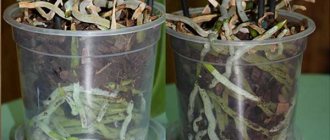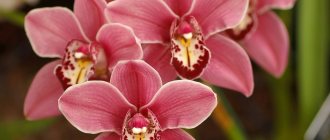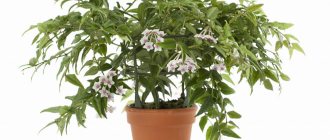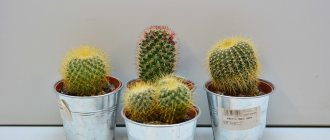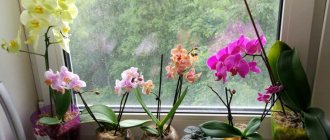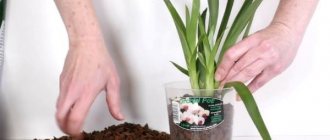The history of the orchid
It first appeared on our earth 130 million years ago. The first to see the unusual flower were the inhabitants of Ancient China. It received its name from the philosopher Theophrastus. The scientist compared paired bulbs (rhizome) with male testicles. As a result, the culture was named "orchis". Translated from Greek as “testicle”.
In Europe, the first orchid bloomed in 1731. It was brought by an unknown missionary from the Bahamas. At the beginning of the 19th century in England, the plant began to be used as packaging material. But the gardener, who became interested in the plant, planted it in a pot, and was pleasantly surprised by the result. Farms began to massively export the crop from its natural distribution. For a long time they asked for huge amounts of money for it.
Important! Today, there are 30,000 species of wild orchids, and 150,000 species of hybrids.
What do different varieties bring to humans?
Danger
Such a beautiful flower in some cases poses a mortal danger. Whether the plant will have a harmful effect or not depends on the type of orchid . Tropical orchids are harmful to the home, but hybrid varieties are what you need.
So, the following varieties are classified as harmful orchids:
Cymbidium.- Wanda.
- Sarcochymus.
- Phragmipedium.
Benefit
In fact, there are many more varieties of orchids allowed for growing at home . But most often flower growers choose the following options:
Neophinetia.- Aranda.
- Miltonia.
- Cumbria.
- Ludisia.
- Mokara.
- Vascostilis.
You can read a lot of interesting things about this amazing flower on our website: where it comes from and what is the largest orchid in the world, how many years does the plant live and how to choose the right flower when buying. You may be interested in learning about the structure of an orchid, methods of propagation and proper care of the plant.
Useful and healing properties of orchids
Both the health benefits and harms of orchids have been known since ancient times. Healers used the rhizome as the main ingredient to treat diseases. Representatives of orchids have a number of positive properties.
Common types and their beneficial effects on the body:
- Crepidium acuminatum - medicines are made from this terrestrial orchid to strengthen the immune system, the plant stimulates sperm production and is used as an aphrodisiac.
- Calanthe triplicata – the benefit is to obtain a medicine to reduce swelling of the hands. Healthy orchid flowers serve as a pain reliever. The root of this species will help get rid of diarrhea.
- Anoectochilus regalis – leaves are beneficial for the whole body. Medicinal oil is made from the flowers to help with diseases.
- Acampe papillosa – the root has beneficial properties. Often used for gynecological diseases, syphilis, rheumatism, neuralgia.
- Corymborkis veratrifolia is a useful but rare species of orchid that helps to cope with fever in a child (the juice from the young leaves is used).
- Dendrobium nobile is a common species; a medicine for pain is made from the leaves and roots to normalize the functioning of the gastrointestinal tract.
Orchid is a useful flower used to treat many ailments due to its unique properties. In the 16th and 17th centuries, the Aztec leader was prepared with a special drink for sexual activity, which helped to please his 600 wives. It consisted of orchid, vanilla, hot pepper and cocoa beans. The benefit also lies in the content of medicinal substances in the plant organs.
We recommend reading: Chili peppers: benefits and harms, properties, how to eat them
Allergic reactions to certain types of orchids
Allergies can most often be caused by plants brought directly from tropical climates .
Allergies can only be caused by natural varieties of orchids.
Such reactions of the human body as headache, nausea, dizziness and others can be explained by the strong specific smell of perennial exotics. such unsafe specimens away from children , since a harmful plant can have negative consequences for them.
The use of orchids in folk medicine
Our ancestors, who knew about the harm and benefits of every wild plant, actively used the leaves and rhizomes to treat colds, relieve pain after a burn, treat abscesses, inflammation and sexual disorders.
Important! It is prohibited to use traditional medicine recipes without consulting a doctor.
Popular recipes:
- Tonic tincture. Grind the dried orchis tubers (a representative of the orchids) to a powder. Pour 1 tbsp. l. warm boiled water (10 tbsp). Stir and let sit for 15 minutes. Add 90 tbsp to the mass. l. boiling water, bring to a state resembling mucus. Use 40 g once a day. The benefit is to increase vitality and improve muscle tone.
- Infusion for impotence. Pour red wine (a glass will be enough) 2 tbsp. l. crushed tubers of Lyubka bifolia. Leave for 2 weeks, stir the mixture daily with a wooden spoon. Take 4 times a day before meals, 1 tbsp. Harm from the infusion will occur with uncontrolled treatment.
We recommend reading: The benefits of white wine and how to make it at home
In our country, dried yarysh tubers are most often used. The medicinal powder helps with diarrhea, inflammation of the gallbladder, impotence, hemorrhoids, and diabetes. It won't do any harm. The main treatment is to carry out according to the instructions or recommendations of the doctor.
We recommend reading: Benefits of bell pepper, properties
The use of orchids in cooking
Dendrobium (Dendrobium) is a common representative of orchids in cooking. The aromatic leaves are used in Malaya to season rice. The culture is added to salads. In some Asian countries, they are fried in batter and added to various sauces, the benefits of which increase significantly. Chefs from European countries decorate desserts with Dendrobium flowers.
Due to their aroma and beneficial properties, many types are used as an additive to tea. Vanilla is made from the fruit of Vanilla planifolia. The spice is known in cooking and perfumery. The species grows in Africa, Central America and Mexico.
Description of the plant
Different types of this crop can differ significantly in the structure, shape of flowers and their color.
Depending on their lifestyle, all orchids are divided into:
- Saprophytic - plants with a simple stem covered with scales, on which there are no leaves and only one flower develops.
- Terrestrial - mostly low plants up to 2 m, with green leaves and underground rhizomes.
- Epiphytic - located on trees, attaching their roots to their bark. They have whole, alternate leaves and inflorescences in the form of a spike or brush.
The minimum size of the flowers of this plant is only 2-3 cm, and the maximum is about 35 cm. The flowers can be single or collected in racemes.
Given the wide variety of species and varieties (up to 30 thousand), the color of the flowers can be any color: from white to black, but completely black orchids do not exist.
The chemical composition of this plant depends on its variety and place of growth. Most types contain:
- alkaloids;
- minerals: magnesium, sodium, potassium, iron, calcium.
The essential oil, which is extracted from the buds, contains antioxidants and fatty amino acids.
The composition of vanilla, which also belongs to the Orchidaceae family, includes:
- resins;
- tannins;
- mucus.
Signs and superstitions of orchids in the house
Much is already known about the benefits, harms and medicinal properties. Orchid is endowed with a huge number of components that have a beneficial effect on the body. But there are superstitions regarding growing flowers in an apartment. Some people are sure that it can cause harm and will disrupt the peace and quiet in the family.
In the Middle Ages, people thought that orchids could only be kept by special people, the talented, the most developed, that is, those who stand out from the crowd. Flowers were presented to beloved, most beautiful girls to express admiration for their appearance.
Culture is endowed with human traits. It is believed that the plant is beneficial if you learn how to properly care for it. The orchid should not be allowed to wilt or become diseased. If you treat her with love and attention, then it will “thank” the owner and be beneficial.
If a person who is hostile or wants to cause harm comes to the apartment, then the orchid is able to drive him away. There is a superstition that its properties will make the enemy feel bad: they will get sick or dizzy, and nausea will begin.
Its color is of great importance for the plant. This is one of the most important properties of a plant that can affect the home atmosphere. Many people advise taking into account the principles of Feng Shui.
Orchid - energy vampire
The flower is called an energy vampire. There is an opinion that representatives of the family draw out all the strength and energy from people. The owner feels a relationship between a bad mood and the state of culture. Everything comes from flower pollen, which acts as a sedative so much that a person does not suffer from insomnia.
Orchid drives men out of the house
This superstition is not true. Suspicious women shift all responsibility for family relationships onto the flower and believe that it causes harm in interactions between lovers.
Some types serve as a talisman for girls, endowing them with talent and inspiring creativity. With proper care of a flower, it will give a woman beauty and youth, improve health, mood and increase attractiveness. The magical properties of the orchid will drive all negative energy and anger out of the house.
How is it harmful to the body?
For most people, indoor orchids are not dangerous. The exception is people who are allergic to the pollen of this plant.
An orchid allergy is accompanied by symptoms:
- lacrimation;
- redness of the eyes;
- sneezing;
- nasal congestion;
- cough;
- runny nose;
- skin itching and redness.
If you are allergic to orchid pollen, you should avoid keeping this plant in your home or workplace. The aroma of the plant attracts blood-sucking insects.
Moreover, some orchid varieties use mosquitoes as their main pollinators . If there is a flower pot near an open window, the room will soon quickly become filled with insects.
An orchid standing on the bedside table can also worsen sleep: in the dark, the flower produces the most intense aroma, which makes it difficult to relax and fall asleep.


